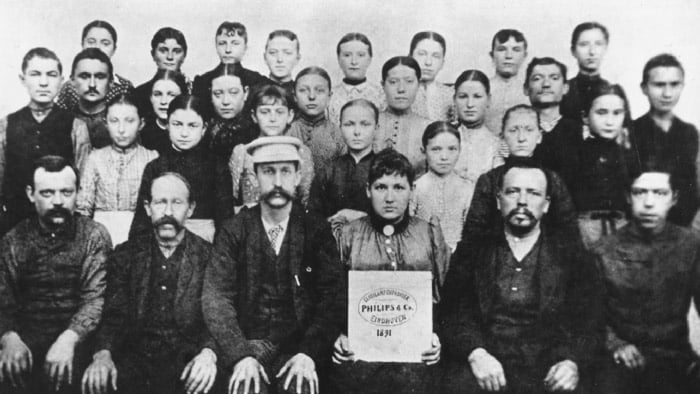When discussing technological progress and innovation, few companies have had as significant an impact as Philips. With roots that stretch back over a century, Philips has cultivated a remarkable legacy across industries spanning from lighting to healthcare. Let’s delve into the company’s transformation from a modest Dutch startup to a global health technology giant. Uncover the advanced capabilities of the Philips 5500 LatteGo review
Humble Beginnings: The Foundation of Philips
Philips was founded in 1891 by Gerard Philips and his father, Frederik Philips, in Eindhoven, Netherlands. Initially focused on manufacturing carbon-filament lamps, the company’s early years were fraught with financial challenges and fierce competition. However, their dedication to producing quality products laid the groundwork for Philips’ evolution into a leader in electronics. Get a closer look at the features of the Philips 5400 LatteGo review
Innovation Lays the Path to Success
By the early 20th century, Philips had established itself as one of Europe’s prominent light bulb manufacturers. Their growth was not merely a result of large-scale production but also a commitment to innovation. In 1914, they established the Research Laboratory (NatLab), which became a hub for creativity and technological progress, driving the company into new growth areas. Compare these two machines side by side in the Philips LatteGo 5400 vs 4300 review

Stepping into Radio Technology
In the 1920s and 1930s, Philips expanded into the burgeoning field of radio technology. In 1927, the company began producing radios, anticipating the rising interest in radio broadcasting. By 1932, they had sold over a million units, demonstrating their ability to precisely meet consumer demand. Discover the differences among these models in the Philips 3200 vs 4300 vs 5400 review
Resilience During World War II
World War II presented Philips with immense challenges, including disrupted operations and damaged facilities. Despite these adversities, the company demonstrated extraordinary resilience. They relocated key personnel, enabling vital research to continue, which contributed to advancements in radar and other wartime technologies. This period exemplified their adaptability and determination. Learn how these two models compare in the Philips 3200 vs 4300 review
Post-War Era: Launching the Audio Cassette
After the war, Philips entered a new phase of technological innovation. In 1963, they launched the compact audio cassette, revolutionizing the way people recorded and listened to music. This invention became a global phenomenon, securing Philips’ position as a leader in consumer technology. See what sets these models apart in the Philips 3200 vs 5400 review
Revolutionizing Music with the Compact Disc
In collaboration with Sony, Philips launched the compact disc (CD) in the late 1970s, forever changing the music industry with a durable, high-quality format for digital audio. This milestone showcased Philips’ ability to foster global partnerships and push technological limits, reshaping entertainment as we knew it. Get a detailed review of the Philips LatteGo 5400 review
Diversifying into Consumer Electronics and Television
Throughout the latter half of the 20th century, Philips continued to diversify, playing a pivotal role in developing the VHS format and, later, the DVD, redefining home entertainment standards. Innovations such as the Ambilight TV in the 1990s further cemented their reputation as leaders in consumer electronics. Discover the compact and efficient design of the Philips 3200 LatteGo review
Shifting Towards Healthcare Technology
In the 1980s, Philips began shifting its focus towards healthcare technology, recognizing its enormous potential. They invested in medical imaging, patient monitoring, and health informatics, gradually becoming a key player in the health tech industry. Strategic acquisitions and cutting-edge technologies allowed Philips to build a diverse portfolio dedicated to improving healthcare outcomes. Dive into the advanced features of the Philips 4300 LatteGo review
Focusing on Health and Lighting Solutions
In recent years, Philips has strategically refocused its priorities, transitioning from traditional consumer electronics to health technology and lighting. In 2016, Philips spun off its lighting division, which rebranded as Signify, enabling Philips to dedicate its efforts to health technology. This move mirrored the broader global trend towards prioritizing health and well-being.
Commitment to Sustainability and Corporate Social Responsibility
Philips has consistently shown its dedication to sustainability and social responsibility. They have set ambitious targets, such as achieving carbon-neutral operations and adopting circular economy principles, demonstrating their commitment to environmentally responsible practices and societal well-being.
Harnessing the Digital Transformation
Philips has embraced the digital era by leveraging artificial intelligence (AI) and data analytics to improve its products and services. Focusing on connected care and smart health solutions, Philips continues to position itself as an innovation leader, ready for a future where technology plays an essential role in healthcare delivery and patient outcomes.

Conclusion: A Legacy Built on Innovation and Resilience
The journey of Philips is a powerful testament to the strength of innovation and adaptability. From its beginnings in light bulb production to becoming a leader in health technology, Philips has continually evolved to meet society's changing needs. Their impact has spanned various industries, from transforming music consumption to pioneering advancements in healthcare.
As Philips continues to innovate and tackle global challenges, their legacy serves as a shining example of how a commitment to technological progress and societal betterment can create a lasting impact. The future looks promising, building upon the rich history that has brought Philips to its current standing.
